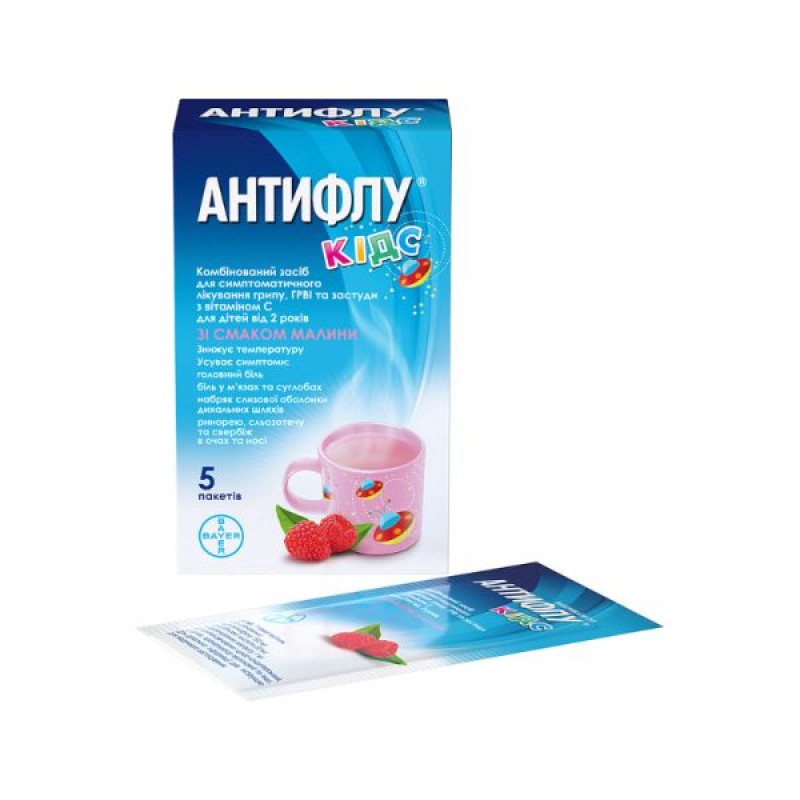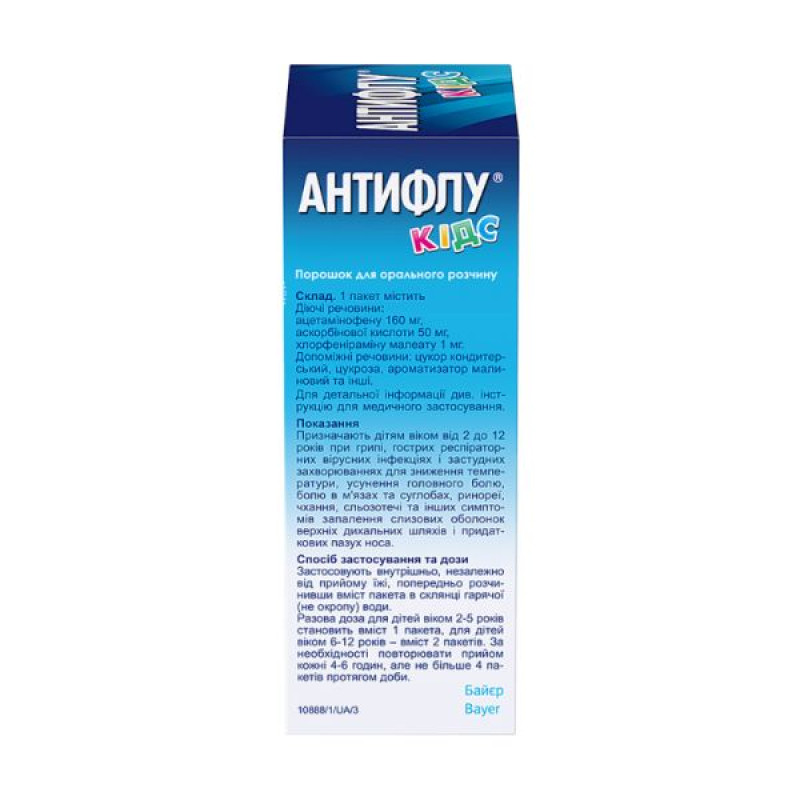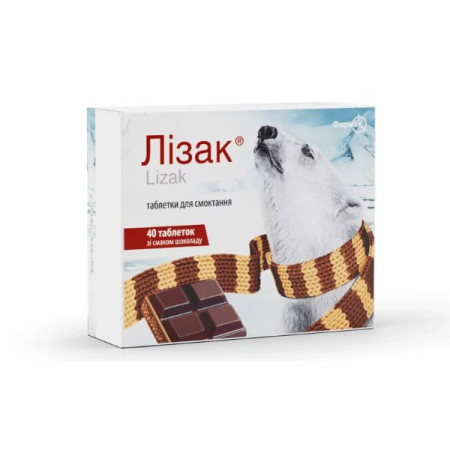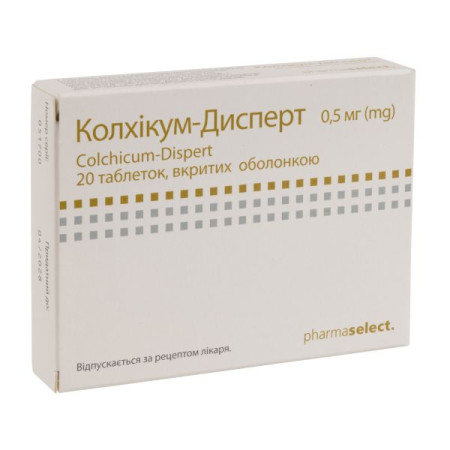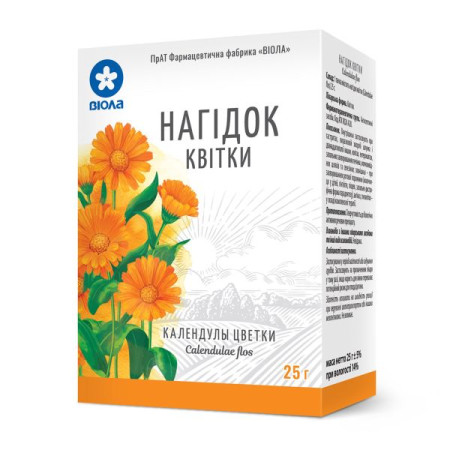Antiflu Kids powder package No. 5
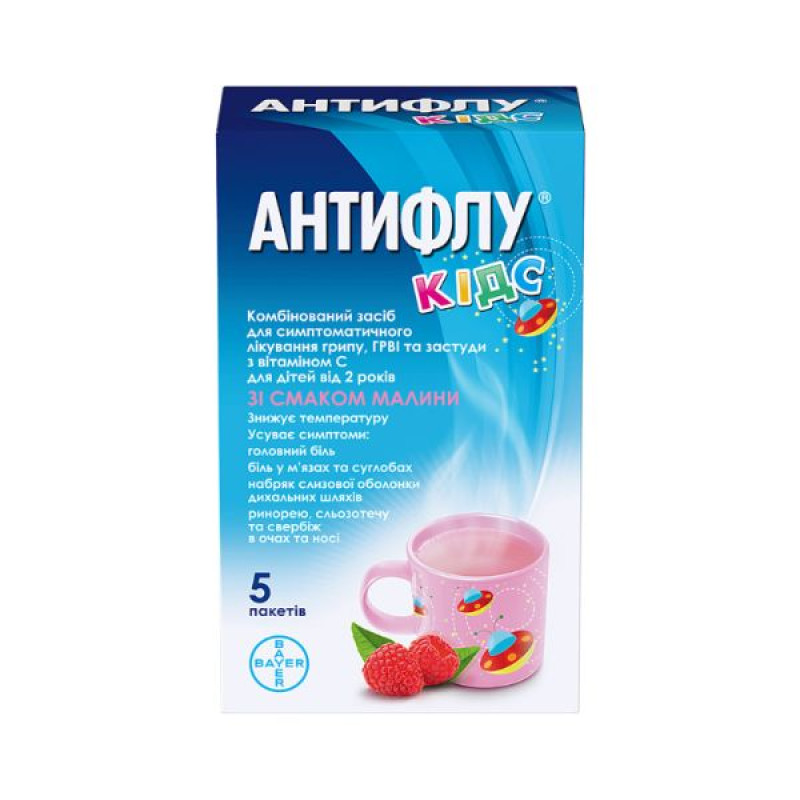
Instructions for Antiflu Kids powder package No. 5
Composition
active ingredients: acetaminophen, ascorbic acid, chlorpheniramine maleate;
1 packet contains acetaminophen 160 mg, ascorbic acid 50 mg, chlorpheniramine maleate 1 mg;
excipients: citric acid anhydrous, silicon dioxide, colloidal silicon dioxide anhydrous, sodium citrate dihydrate, corn starch, confectioner's sugar, sucrose, titanium dioxide (E 171), calcium phosphate, special red AC (E 129), raspberry flavor.
Dosage form
Powder for oral solution.
Main physicochemical properties: white or almost white free-flowing powder containing crystalline particles, with a slight raspberry odor.
Pharmacotherapeutic group
Analgesics and antipyretics. ATX code N02B E51.
Pharmacological properties
Pharmacodynamics.
Acetaminophen has analgesic, antipyretic, and weak anti-inflammatory effects. Its mechanism of action is to inhibit prostaglandin synthesis and affect the thermoregulatory center in the hypothalamus.
Ascorbic acid (vitamin C) as a key component of the antioxidant and immune defense system increases the body's adaptive capabilities, increases its resistance to infections. Takes an active part in the regulation of redox processes, in carbohydrate metabolism, in the synthesis of steroid hormones, catecholamines and blood clotting. Enhances collagen synthesis, stimulates regeneration processes, normalizes capillary permeability.
Chlorpheniramine maleate is an antihistamine of the alkylamine class, a blocker of H1-histamine receptors. It has an antiallergic effect, eliminates rhinorrhea, lacrimation and itching in the eyes and nose. The therapeutic effect develops within one hour after oral administration and lasts for 24 hours.
The components of the drug are metabolized independently of each other.
Pharmacokinetics.
After oral administration, acetaminophen is rapidly absorbed, mainly in the upper gastrointestinal tract. It is rapidly distributed in tissues. Binding to blood proteins is less than 10%. Acetaminophen is metabolized primarily in the liver: most of it is bound to glucuronic acid, less to sulfuric acid. The half-life of acetaminophen is 2–2.5 hours. It is prolonged in individuals with liver disease.
Acetaminophen is excreted in the urine (85% of a single dose of acetaminophen is excreted within 24 hours). Excretion is significantly impaired in cases of impaired renal excretory function, which can lead to the accumulation of acetaminophen and its metabolic products in the body. Ascorbic acid is actively absorbed in the small intestine. After oral administration, the maximum concentration in blood plasma is reached after 4 hours. From blood plasma, it easily penetrates into leukocytes, platelets and almost all tissues. It undergoes biotransformation in the liver, is excreted in the urine: partly in an unchanged state, partly in the form of metabolites.
Chlorpheniramine maleate is metabolized in the liver. The half-life is 8 hours. Chlorpheniramine maleate and its metabolites are excreted in the urine.
Indication
Prescribed for children aged 2 to 12 years for influenza, acute respiratory viral infections and colds to reduce fever, eliminate headache, muscle and joint pain, rhinorrhea, sneezing, tearing and other symptoms of inflammation of the mucous membranes of the upper respiratory tract and paranasal sinuses.
Contraindication
Increased individual sensitivity to the ingredients of the drug or to other antihistamines; severe liver dysfunction (> 9 points on the Child-Pugh scale) and/or kidneys, alcoholism; congenital deficiency of glucose-6-phosphate dehydrogenase; congenital hyperbilirubinemia (including Gilbert's syndrome); hematopoietic disorders, blood diseases, severe leukopenia, anemia, tendency to thrombosis; severe cardiac conduction disorders, decompensated heart failure; bladder neck obstruction; pyloroduodenal obstruction; thrombosis, thrombophlebitis; severe forms of diabetes mellitus; angle-closure glaucoma; gastric and duodenal ulcer in the acute stage; children's age up to 2 years.
Do not use with monoamine oxidase (MAO) inhibitors and within 2 weeks of discontinuing MAO inhibitors. MAO inhibitors should not be used with antihistamines due to the potential for additive CNS depression. They may prolong and potentiate the anticholinergic effects of antihistamines.
Interaction with other medicinal products and other types of interactions
When used simultaneously with acetaminophen, the following types of interactions are possible:
slowing down the elimination of antibiotics from the body;
anticonvulsants (including phenytoin, barbiturates, carbamazepine), rifampicin, and alcohol enhance the hepato- and nephrotoxicity of acetaminophen;
barbiturates reduce the antipyretic effect of acetaminophen;
tetracycline increases the risk of developing anemia and methemoglobinemia caused by acetaminophen;
When paracetamol is used simultaneously with hepatotoxic drugs, the toxic effect of the drugs on the liver increases; do not use simultaneously with alcohol;
Concomitant use of high doses of acetaminophen with isoniazid or rifampicin increases the risk of developing hepatotoxic syndrome;
increased effect of indirect anticoagulants with an increased risk of bleeding;
the rate of absorption of acetaminophen is increased by metoclopramide and domperidone and decreased by cholestyramine;
with simultaneous long-term use with coumarin derivatives (e.g. warfarin) may enhance their effect with an increased risk of bleeding; patients taking oral anticoagulants should consult a doctor, blood clotting parameters should be monitored;
taking paracetamol (acetaminophen) may affect the results of blood glucose determination using the glucose oxidase-peroxidase method with abnormally high concentrations;
taking paracetamol may affect the results of blood urea determination using the phosphotungstic acid method;
Tropisetron and granisetron, type 3 5-hydroxytryptamine antagonists, can completely block the analgesic effect of paracetamol due to pharmacodynamic interaction;
simultaneous use of paracetamol and zidovudine increases the tendency to reduce the number of white blood cells (neutropenia), therefore these medicines should not be used simultaneously unless otherwise recommended by a doctor;
Absorption of ascorbic acid is reduced with simultaneous use of oral contraceptives, consumption of fruit or vegetable juices, and alkaline drinks;
Ascorbic acid, when taken orally, increases the absorption of penicillin, tetracycline, and iron, increases the level of ethinyl estradiol, reduces the effectiveness of heparin and indirect anticoagulants, and increases the risk of crystalluria during treatment with salicylates;
simultaneous administration of vitamin C and deferoxamine increases tissue iron toxicity, especially in the heart muscle, which can lead to decompensation of the circulatory system; vitamin C can be taken only 2 hours after the injection of deferoxamine;
large doses of the drug reduce the effectiveness of tricyclic antidepressants, neuroleptics - phenothiazine derivatives, tubular reabsorption of amphetamine, and disrupt the excretion of mexiletine by the kidneys;
ascorbic acid increases the total clearance of ethyl alcohol;
Quinoline drugs, calcium chloride, salicylates, and corticosteroids, when used for long periods of time, reduce the body's stores of ascorbic acid.
Simultaneous use of Antiflu® Kids with such drugs as hypnotics, sedatives, neuroleptics, tranquilizers can significantly increase the suppressive effect of chlorpheniramine maleate.
Chlorpheniramine enhances the anticholinergic effects of atropine, antispasmodics, tricyclic antidepressants, antiparkinsonian drugs. Monoamine oxidase inhibitors (MAOIs) should not be administered in combination with antihistamines due to the potential for additive CNS depressant effects. They may prolong and potentiate the anticholinergic effects of antihistamines.
Caution should be exercised when using paracetamol concomitantly with flucloxacillin, as concomitant administration has been associated with high anion gap metabolic acidosis, especially in patients with risk factors (see section 4.4).
Application features
Concomitant use with other drugs intended for the symptomatic treatment of colds and flu, drugs containing paracetamol should be avoided. Do not exceed the indicated dose and duration of treatment. Concomitant use with other drugs containing paracetamol may lead to overdose. Paracetamol overdose may cause liver failure, which may require liver transplantation or be fatal.
Patients with low glutathione levels, for example those with severe infections such as sepsis, are at increased risk of metabolic acidosis when taking paracetamol. Symptoms of metabolic acidosis include deep, rapid or difficult breathing, nausea, vomiting, loss of appetite. You should seek medical attention immediately if you experience these symptoms.
If symptoms persist, you should consult a doctor.
Prolonged use of high doses may lead to liver and kidney damage; a large number of concomitant medications, alcoholism, alcoholic liver disease, sepsis, or diabetes mellitus may increase the risk of hepatotoxicity of paracetamol (acetaminophen) at therapeutic doses.
It should be noted that patients with liver disease are at increased risk of hepatotoxicity from paracetamol. It is necessary to consult a doctor regarding the possibility of using the drug in patients with mild to moderate renal and hepatic impairment.
This medicine is not recommended for use simultaneously with sedatives or hypnotics.
Before using the drug, it is necessary to consult a doctor if the patient is using warfarin or similar drugs that have an anticoagulant effect.
The drug should be prescribed by a doctor only after assessing the risk/benefit ratio in the following cases: severe arterial hypertension, epilepsy, glaucoma, oxalaturia, urination disorders, urinary retention, prostate enlargement, asthma, respiratory disorders due to bronchitis, croup or pneumonia, thyrotoxicosis, glutathione deficiency.
Caution is advised when prescribing paracetamol concomitantly with flucloxacillin due to the increased risk of high anion gap metabolic acidosis (HAGMA), particularly in patients with severe renal insufficiency, sepsis, malnutrition and other sources of glutathione deficiency (e.g. chronic alcoholism), and those taking maximum daily doses of paracetamol. Close monitoring, including measurement of urinary 5-oxoproline, is recommended.
The recommended dose and duration of treatment should not be exceeded. If, on the recommendation of a doctor, the drug is used for a long period, it is necessary to monitor the functional state of the liver and the picture of peripheral blood.
Severe skin reactions have been reported very rarely. If you experience redness, rash, blistering or peeling of the skin, stop using paracetamol and seek medical attention immediately.
1 packet (1 dose) contains 11.6 g of sugar, which should be taken into account by diabetics and patients on a low-sugar diet. Use with caution in diabetics. Simultaneous administration of the drug with alkaline drinks reduces the absorption of ascorbic acid, so you should not wash down the powder with alkaline mineral water. Also, the absorption of ascorbic acid may be impaired in intestinal dyskinesias, enteritis and achilia.
This medicinal product should not be used in cases of fructose intolerance, glucose-galactose malabsorption or sucrase-isomaltase insufficiency, due to the sucrose content. If you have been told by your doctor that you have an intolerance to some sugars, contact your doctor before taking this medicinal product.
In case of high body temperature or prolonged fever that persists for 3 days while using the drug, or if signs of superinfection appear, you should consult a doctor.
Ascorbic acid may alter the results of laboratory tests (glucose, blood bilirubin, transaminase activity).
Do not take the drug with other remedies for the symptomatic treatment of colds and flu that contain paracetamol or antihistamines. If symptoms persist, you should consult a doctor. If the headache becomes persistent, you should also consult a doctor.
Chlorpheniramine maleate may mask the symptoms of hypersensitivity reactions and affect the results of skin tests. Therefore, the drug should be discontinued a few days before these procedures.
Use during pregnancy or breastfeeding
Not used.
Ability to influence reaction speed when driving vehicles or other mechanisms
Due to the possibility of drowsiness after using chlorpheniramine maleate, children should be advised not to engage in activities that require increased concentration for 4 hours after taking the drug.
Method of administration and doses
It is used internally, regardless of meals, having previously dissolved the contents of the sachet in a glass of hot (not boiling) water. The recommended amount of water for dissolving the powder is usually the volume that the child drinks in one go (100–200 ml). A single dose for children aged 2–5 years is the contents of 1 sachet, for children aged 6–12 years – the contents of 2 sachets. If necessary, repeat the dose every 4–6 hours, but no more than 4 sachets during the day. The maximum period of use without consulting a doctor is 3 days. Further use is possible only under the supervision of a doctor.
Children
Do not use in children under 2 years of age. Consult a doctor before using this medicine in children aged 2–5 years.
The maximum dose for children is up to 100 mg/kg per day or 4000 mg per day.
Overdose
No cases of overdose with Antiflu® Kids have been reported. Symptoms of drug overdose consist of manifestations of intoxication of individual active ingredients.
In patients with risk factors, therapeutic doses of paracetamol may cause symptoms of overdose with the simultaneous use of certain drugs (see section "Interaction with other drugs and other types of interactions") and in diseases that increase oxidative stress and deplete glutathione reserves in the liver (prolonged fasting, sepsis, diabetes mellitus).
Symptoms of acetaminophen overdose include pallor, nausea, vomiting, anorexia, malaise, and abdominal pain within the first 24 hours. The patient may improve within 24–48 hours, although symptoms may persist.
When taking large doses, psychomotor agitation or depression of the central nervous system, increased sweating, dizziness, and sleep disturbances are also possible.
Occasionally, nephrotoxicity has been observed from the urinary system, including renal colic, interstitial nephritis and acute renal failure with acute tubular necrosis, which may present with severe lower back pain, hematuria, proteinuria and may develop even in the absence of severe liver damage. In severe cases, liver damage (hepatocellular necrosis) and deterioration of its function may occur, which may progress to hepatic encephalopathy, hepatic coma, cerebral edema and be fatal. Clinical signs of liver damage may not appear for 12–48 hours after overdose. The liver size increases rapidly. Disorders of glucose metabolism, hypokalemia and metabolic acidosis (including lactic acidosis), increased activity of hepatic transaminases, increased bilirubin and increased prothrombin index, hemorrhages may occur. The amount of urine decreases, mild azotemia may be observed. Liver damage may develop in a child after administration of more than 150 mg/kg of body weight. Common clinical manifestations that appear after 3–5 days include jaundice, fever, hemorrhagic diathesis, hypoglycemia, hepatic halitosis, and liver failure.
The use of 5 g or more of paracetamol can lead to liver damage in patients with risk factors (long-term treatment with carbamazepine, phenobarbital, phenytoin, primidone, rifampicin, St. John's wort or other drugs that induce liver enzymes; regular intake of excessive amounts of ethanol; glutathione cachexia (digestive disorders, cystic fibrosis, HIV infection, starvation, cachexia)).
Arrhythmia (heart rhythm disturbance) and pancreatitis have also been noted. When taking large doses, from the central nervous system - disorientation.
With prolonged use in high doses, aplastic anemia, pancytopenia, agranulocytosis, neutropenia, leukopenia, and thrombocytopenia are possible.
Chronic intoxication includes various liver lesions. Data on chronic toxicity and especially nephrotoxicity of paracetamol are contradictory. With prolonged use, attention should be paid to peripheral blood analysis.
In case of an overdose of chlorpheniramine maleate, atropine-like symptoms may occur: mydriasis, photophobia, dry skin and mucous membranes, increased body temperature (hyperpyrexia), tachycardia, intestinal atony, facial flushing. Usually, symptoms of central nervous system excitation are first observed (psychomotor agitation, psychosis, hallucinations, tremor, impaired motor coordination, hyperreflexia, convulsions), and then depression, drowsiness, impaired consciousness, which are accompanied by respiratory disorders and impaired functioning of the cardiovascular system (heart rhythm disturbances, extrasystole, decreased pulse rate, decreased blood pressure up to vascular insufficiency and death).
Emergency care for antihistamine poisoning consists of symptomatic and supportive treatment, including artificial ventilation of the lungs.
Emergency care. The patient should be immediately transferred to the hospital intensive care unit, even if there are no early symptoms of overdose. Continuous monitoring of vital signs, laboratory data and cardiovascular status should be ensured. Symptoms may be limited to nausea and vomiting or may not reflect the severity of the overdose or the risk of organ damage. Treatment with activated charcoal should be considered if an overdose of paracetamol has been taken within 1 hour. The concentration of paracetamol in the blood plasma should be measured 4 hours or later after ingestion (earlier concentrations are unreliable). Gastric lavage should be performed within 6 hours of a suspected acetaminophen overdose. Hemodialysis and hemoperfusion contribute to the elimination of the substance. Cytotoxic effects can be reduced by administering SH-group donors (methionine orally or cysteamine or N-acetylcysteine intravenously) within 10 hours of overdose, as they bind to active metabolites and promote detoxification. N-acetylcysteine may be effective for up to 48 hours after poisoning. The effectiveness of the antidote decreases sharply after this period.
High doses of ascorbic acid (more than 3,000 mg) can cause temporary osmotic diarrhea and gastrointestinal upset.
Treatment: wash the stomach, give the patient an alkaline drink, activated charcoal or other absorbents.
Side effects
In most cases, the drug is well tolerated.
The following undesirable effects may occur:
from the blood system: anemia, sulfhemoglobinemia and methemoglobinemia (cyanosis, dyspnea, heart pain), hemolytic anemia (if the patient has glucose-6-phosphate dehydrogenase deficiency), thrombocytopenia, thrombocytosis, hyperprothrombinemia, erythropenia, neutrophilic leukocytosis, agranulocytosis, thrombocytopenic purpura, leukopenia, bruising or bleeding;
Respiratory system: bronchospasm in patients sensitive to acetylsalicylic acid or other nonsteroidal anti-inflammatory drugs;
from the digestive tract: dyspepsia, nausea, vomiting, dry mouth, discomfort and pain in the epigastric region, hypersalivation, decreased appetite, heartburn, diarrhea;
from the endocrine system: hypoglycemia up to hypoglycemic coma, damage to the insular apparatus of the pancreas (hyperglycemia, glucosuria) and impaired glycogen synthesis up to the onset of diabetes mellitus;
On the part of the hepatobiliary system: impaired liver function, increased activity of liver enzymes, usually without the development of jaundice, hepatonecrosis (dose-dependent effect);
Immune system disorders: hypersensitivity reactions (including allergic reactions), anaphylactic reactions and anaphylactic shock;
from the nervous system: headache, dizziness, psychomotor agitation and disorientation, anxiety, feelings of fear, sleep disorders, drowsiness, insomnia, confusion, coma, convulsions, dyskinesia, behavioral changes;
from the cardiovascular system: tachycardia, reflex bradycardia, shortness of breath, heart pain, increased blood pressure, arrhythmia, myocardial dystrophy (dose-dependent effect with prolonged use);
from the urinary system: renal colic and interstitial nephritis, urinary retention and difficulty urinating, aseptic pyuria, with prolonged use in high doses - damage to the glomerular apparatus of the kidneys, crystalluria, formation of urate, cystine and/or oxalate stones in the kidneys and urinary tract;
on the part of the organs of vision: accommodation disorders, dry eyes, mydriasis, visual impairment, increased intraocular pressure;
Metabolic: zinc and copper metabolism disorders, hypokalemia;
Skin and subcutaneous tissue disorders: itching, skin and mucous membrane rash (usually generalized rash, erythema, urticaria), allergic and angioedema, acute generalized exanthematous pustulosis, local drug dermatitis, erythema multiforme (including Stevens-Johnson syndrome), toxic epidermal necrolysis (Lyell's syndrome), including fatal outcome.
Expiration date
3 years.
Storage conditions
Store in the original packaging at a temperature not exceeding 25 ºC.
Keep out of reach of children.
Packaging
Powder, dosed at 12 g, in bags made of paper laminated with aluminum foil and polyethylene. 5 bags in a cardboard box.
Vacation category
Without a prescription.
Producer
Contract Pharmacal Corporation.
Location of the manufacturer and its business address
135 Adams Avenue, Hauppauge, New York 11788, USA/135 Adams Avenue, Hauppauge, New York, 11788, USA.
There are no reviews for this product.
There are no reviews for this product, be the first to leave your review.
No questions about this product, be the first and ask your question.







